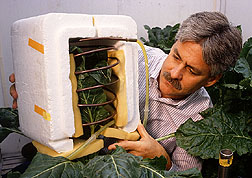Understanding Sugar Transport in Plants
A signal system between the brain and the stomach tells animals to stop eating when their stomachs are full—or, conversely, it lets them know when they need more food.
Scientists for the Agricultural Research Service at Urbana, Illinois, have discovered that plants also have a specialized signaling system that regulates nutrient distribution.
ARS plant physiologist Daniel R. Bush says plants can regulate distribution of nutrients via a signal system that controls the flow of sugar from photosynthetic leaves to nonphotosynthetic tissues, like roots and seeds. These tissues are called sinks, because they must import sugars and amino acids to support plant growth and development.
Plants convert light energy from the sun into biochemical energy that is used to synthesize the sugars and amino acids through the complex photosynthetic process. Up to 80 percent of the products of photosynthesis are transported to sink tissues in the plant's vascular system.
"We have known about the mechanics by which the plant's vascular system transports organic nutrients, for years. But we didn't have any information about how this system is regulated," says Bush. "What we have discovered is that sucrose, the major form of transported sugar, is also a signal molecule that the plant responds to by increasing or decreasing nutrient flow to sink tissues."
When sucrose departs from plant leaves, it flows in the elongated phloem cells that lie end to end, forming a living conduit in the plant's vascular system. A specialized sucrose transport protein first described by scientists in the ARS Photosynthesis Research Unit at Urbana actively loads the sugar into the phloem.
The concentration of sucrose inside the phloem cells is up to 100 times greater than that outside. "This attracts water into the cells and increases the hydrostatic pressure of the leaf phloem," says Bush.
"When sucrose is released from the phloem cells in sink tissues, water also leaves the cells, creating a hydraulic pressure difference between the leaf and the sink phloem. That pressure difference causes a mass flow of solution through the phloem. In many ways, this is very similar to the pressure-driven flow of blood pumped through the human body," says Bush.
By learning more about how plants allocate photosynthetic products, scientists may be able to modify plant growth to increase yields, alter nutritional value, or overcome environmental challenges such as elevated carbon dioxide levels.—By Dawn Lyons-Johnson, formerly with ARS.
This research is part of Improving Plant Biological and Molecular Processes, an ARS National Program described on the World Wide Web at http://www.nps.ars.usda.gov/programs/cppvs.htm.
Daniel R. Bush is in the USDA-ARS Photosynthesis Research Unit, 190 PABL, University of Illinois, 1201 W. Gregory, Urbana, IL 61801; phone (217) 333-6109, fax (217) 244-4419.
"Understanding Sugar Transport in Plants" was published in the March 1999 issue of Agricultural Research magazine.







